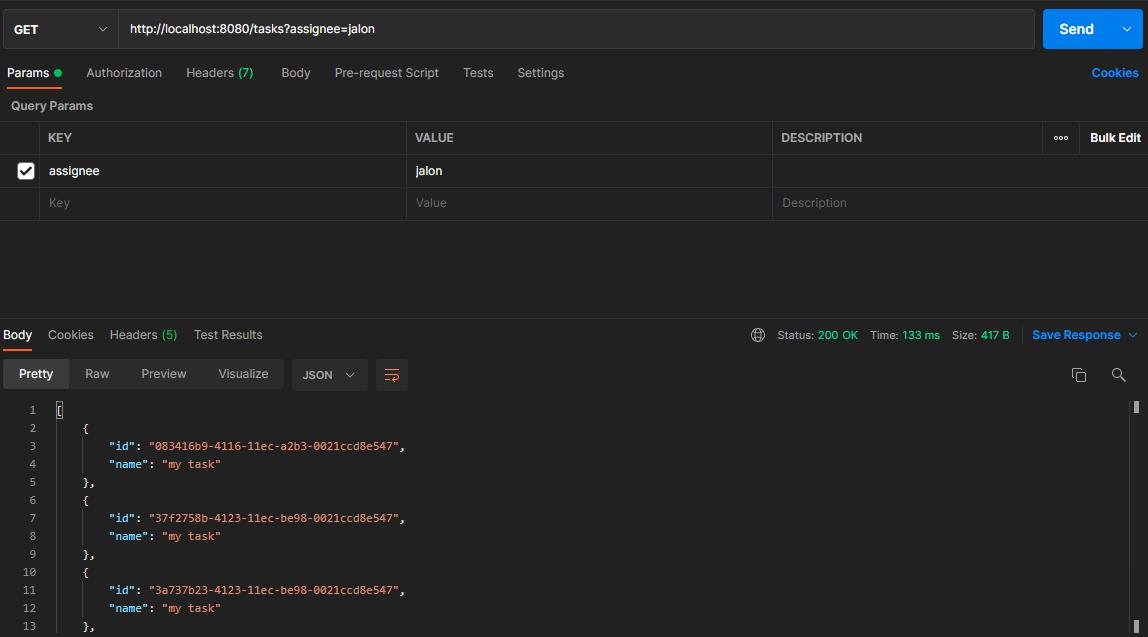#yyds干货盘点#Flowable最新版6.7.0入门篇之基于SpringBoot的例子
Posted 汤圆学Java
tags:
篇首语:本文由小常识网(cha138.com)小编为大家整理,主要介绍了#yyds干货盘点#Flowable最新版6.7.0入门篇之基于SpringBoot的例子相关的知识,希望对你有一定的参考价值。
作者:汤圆
个人博客: javalover.cc
前言
前面我们学习了基于REST API的入门例子;
这一篇我们介绍下最常用的方式,跟Spring Boot的整合
flowable已经有了一个基于Spring Boot的starter,我们可以直接引入
目录
- 创建Spring Boot项目
- 引入flowable starter依赖
- 创建流程定义
- 测试部署状态
- 修改数据库
- 对外提供REST接口
正文
1. 创建Spring Boot项目
这里我们用IDEA直接创建,创建成功后的目录如下所示:
<dependencies>
<dependency>
<groupId>org.springframework.boot</groupId>
<artifactId>spring-boot-starter-web</artifactId>
</dependency>
</dependencies>2. 引入flowable starter依赖
我们先引入flowable-spring-boot-starter和h2依赖;
还有其他的一些依赖,如下所示:
<dependencies>
<dependency>
<groupId>org.flowable</groupId>
<artifactId>flowable-spring-boot-starter</artifactId>
<version>6.7.0</version>
</dependency>
<dependency>
<groupId>com.h2database</groupId>
<artifactId>h2</artifactId>
</dependency>
<dependency>
<groupId>org.springframework.boot</groupId>
<artifactId>spring-boot-starter-web</artifactId>
</dependency>
<dependency>
<groupId>org.springframework.boot</groupId>
<artifactId>spring-boot-devtools</artifactId>
<scope>runtime</scope>
<optional>true</optional>
</dependency>
<dependency>
<groupId>org.springframework.boot</groupId>
<artifactId>spring-boot-configuration-processor</artifactId>
<optional>true</optional>
</dependency>
<dependency>
<groupId>org.projectlombok</groupId>
<artifactId>lombok</artifactId>
<optional>true</optional>
</dependency>
<dependency>
<groupId>org.springframework.boot</groupId>
<artifactId>spring-boot-starter-test</artifactId>
<scope>test</scope>
</dependency>
</dependencies>引入依赖后,我们就可以启动Spring Boot程序,查看打印日志,如下所示:
2021-11-09 11:55:41.200 INFO 8304 --- [ restartedMain] c.j.s.SpringBootFlowableDemoApplication : Started SpringBootFlowableDemoApplication in 55.805 seconds (JVM running for 64.253)看到这一行就表示启动成功了;
这里有几点我们需要注意一下:
- Spring Boot启动时,会自动创建h2数据库,用来存放flowable相关数据
- 所有流程引擎相关的Bean都会被创建
- 资源目录下:
- processes目录内的bpmn流程定义会被自动部署(上一篇我们是调用Flowable REST接口,上传bpmn文件进行部署的)
- case, dmn, forms等目录下的内容也都会被部署
3. 创建流程定义
这里我们创建一个流程定义,路径为:src/main/resources/processes/one-task-process.bpmn20.xml
<?xml version="1.0" encoding="UTF-8"?>
<definitions
xmlns="http://www.omg.org/spec/BPMN/20100524/MODEL"
xmlns:flowable="http://flowable.org/bpmn"
targetNamespace="Examples">
<process id="oneTaskProcess" name="The One Task Process">
<startEvent id="theStart" />
<sequenceFlow id="flow1" sourceRef="theStart" targetRef="theTask" />
<userTask id="theTask" name="my task" flowable:assignee="jalon" />
<sequenceFlow id="flow2" sourceRef="theTask" targetRef="theEnd" />
<endEvent id="theEnd" />
</process>
</definitions>4. 测试部署状态
现在我们编写一个测试方法,用来判断上面的bpmn.xml文件是否部署成功:
package com.jalon.springbootflowabledemo;
import org.flowable.engine.RepositoryService;
import org.flowable.engine.RuntimeService;
import org.flowable.engine.TaskService;
import org.springframework.boot.CommandLineRunner;
import org.springframework.boot.SpringApplication;
import org.springframework.boot.autoconfigure.SpringBootApplication;
import org.springframework.context.annotation.Bean;
@SpringBootApplication
public class SpringBootFlowableDemoApplication
public static void main(String[] args)
SpringApplication.run(SpringBootFlowableDemoApplication.class, args);
@Bean
public CommandLineRunner init(final RepositoryService repositoryService,
final RuntimeService runtimeService,
final TaskService taskService)
return strings ->
System.out.println("Number of process definitions : "
+ repositoryService.createProcessDefinitionQuery().count());
System.out.println("Number of tasks : " + taskService.createTaskQuery().count());
runtimeService.startProcessInstanceByKey("oneTaskProcess");
System.out.println("Number of tasks after process start: "
+ taskService.createTaskQuery().count());
;
这里我们注册了一个CommandLineRunner Bean,这个Bean会在Spring Boot启动时执行;
然后我们重新启动应用,打印如下:说明部署成功
Number of process definitions : 1
Number of tasks : 0
Number of tasks after process start: 1通过打印可以看到,部署了一个流程定义,启动了一个流程任务;
这时如果你重启应用,会发现流程任务还是一个;
是因为默认的数据库h2,重启后数据会丢失;
下面我们可以将其改为mysql试试
5. 修改数据库
首先需要修改依赖,删除h2依赖,引入mysql驱动,并配置数据库参数
<dependency>
<groupId>mysql</groupId>
<artifactId>mysql-connector-java</artifactId>
<version>8.0.11</version>
</dependency>修改application.yml,添加数据库配置:
spring:
datasource:
url: jdbc:mysql://127.0.0.1:3306/flowable-spring-boot?characterEncoding=UTF-8&serverTimezone=UTC&useSSL=false
username: root
password: root本地创建一个数据库flowable-spring-boot
然后重启应用:启动时,flowable会自动创建数据表并填充相关数据
2021-11-09 12:32:22.329 INFO 7944 --- [ restartedMain] c.j.s.SpringBootFlowableDemoApplication : Started SpringBootFlowableDemoApplication in 267.496 seconds (JVM running for 275.771)Number of process definitions : 1Number of tasks : 0Number of tasks after process start: 1此时打印的流程任务为1个,然后我们重启多次,会发现任务数量在增加;
如果是h2数据库,则不会增加,因为h2数据库是基于内存的,重启之后内存数据被清空。
6. 对外提供REST接口
通过对外提供接口,可以很方便地在界面进行交互,包括流程的启动、审批、查询等等
下面我们先创建一个Flowable Service,里面包含了两个方法,一个是启动流程,一个是查询任务(通过分配的用户名)
package com.jalon.springbootflowabledemo;import org.flowable.engine.RuntimeService;import org.flowable.engine.TaskService;import org.flowable.task.api.Task;import org.springframework.beans.factory.annotation.Autowired;import org.springframework.stereotype.Service;import org.springframework.transaction.annotation.Transactional;import java.util.List;@Servicepublic class MyService @Autowired private RuntimeService runtimeService; @Autowired private TaskService taskService; @Transactional public void startProcess() runtimeService.startProcessInstanceByKey("oneTaskProcess"); @Transactional public List<Task> getTasks(String assignee) return taskService.createTaskQuery().taskAssignee(assignee).list(); 上面的runtimeService.startProcessInstanceByKey("oneTaskProcess");中的key就是根据流程定义中的流程id:
<process id="oneTaskProcess" name="The One Task Process">下面我们再创建一个控制器,用来处理用户的请求:
package com.jalon.springbootflowabledemo;import lombok.Data;import org.flowable.task.api.Task;import org.springframework.beans.factory.annotation.Autowired;import org.springframework.http.MediaType;import org.springframework.web.bind.annotation.*;import java.util.ArrayList;import java.util.List;@RestControllerpublic class MyRestController @Autowired private MyService myService; @PostMapping(value="/process") public void startProcessInstance() myService.startProcess(); @RequestMapping(value="/tasks", method= RequestMethod.GET, produces= MediaType.APPLICATION_JSON_VALUE) public List<TaskRepresentation> getTasks(@RequestParam String assignee) List<Task> tasks = myService.getTasks(assignee); List<TaskRepresentation> dtos = new ArrayList<TaskRepresentation>(); for (Task task : tasks) dtos.add(new TaskRepresentation(task.getId(), task.getName())); return dtos; @Data static class TaskRepresentation private String id; private String name; public TaskRepresentation(String id, String name) this.id = id; this.name = name; 这里我们定义了一个数据传输对象TaskRepresentation,用来封装对外返回的数据,封装的数据为任务id和任务名称;
接下来我们重启应用,通过postman来发送请求;
先启动一个实例:
curl -X POST http://localhost:8080/process
再查询任务:
curl http://localhost:8080/tasks?assignee=kermit这里的assignee参数,就是xml中配置的assignee
<userTask id="theTask" name="my task" flowable:assignee="jalon" />这里因为我启动了好几次,所以任务有多个

源码
上传到了github
总结
本篇主要介绍了将Flowable整合到SpringBoot中,配置MySQL数据库,提供REST支持等内容;
可以看到,整合到Spring Boot中之后,使用起来非常简单方便;
以上是关于#yyds干货盘点#Flowable最新版6.7.0入门篇之基于SpringBoot的例子的主要内容,如果未能解决你的问题,请参考以下文章